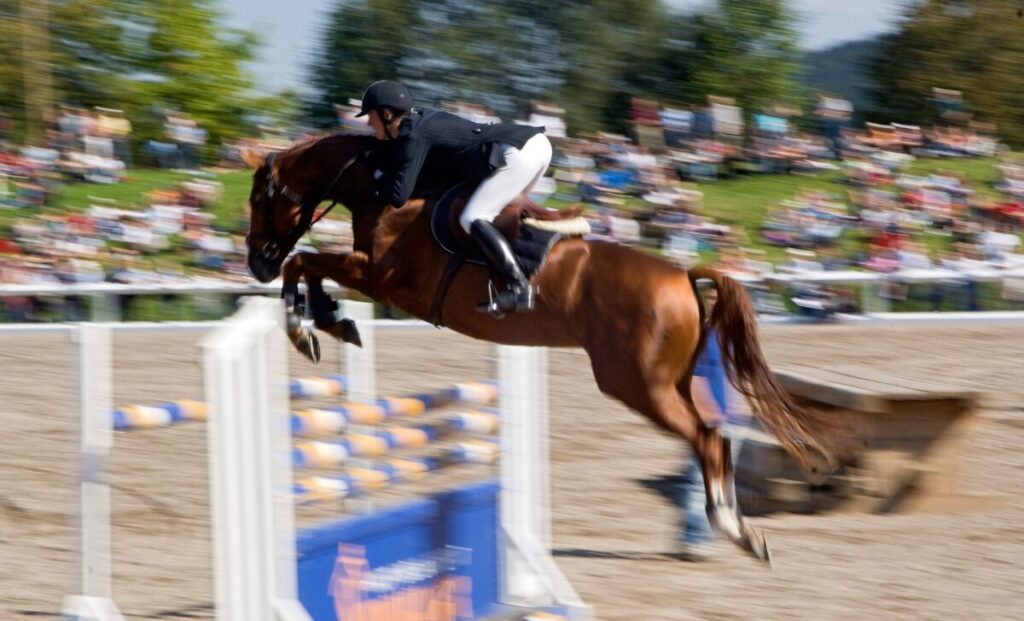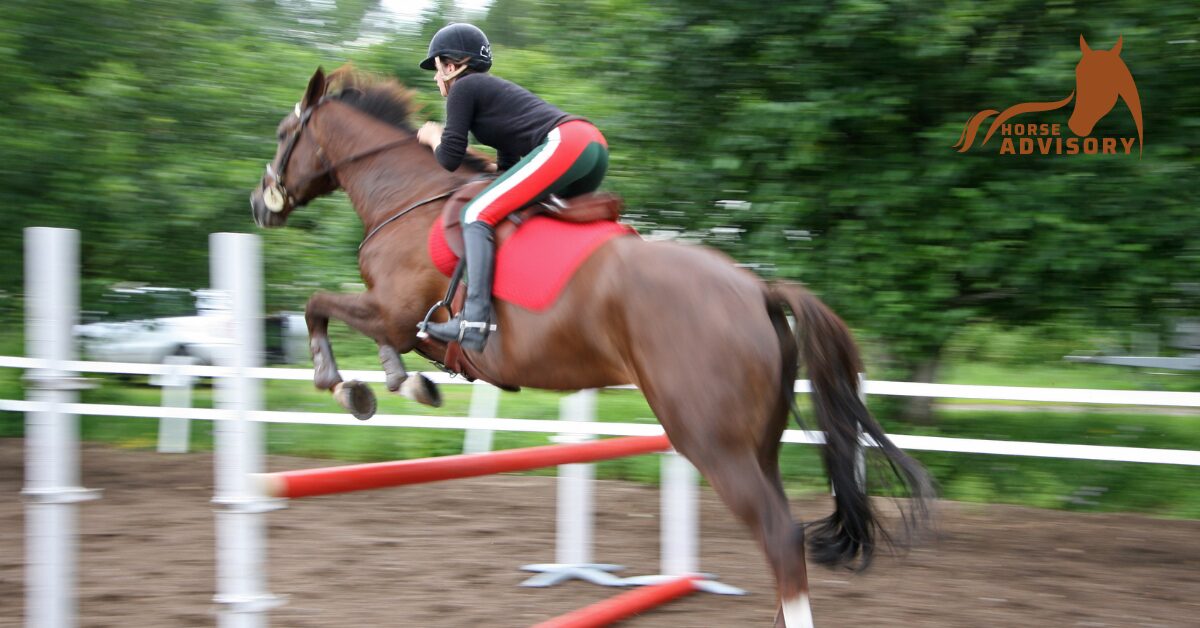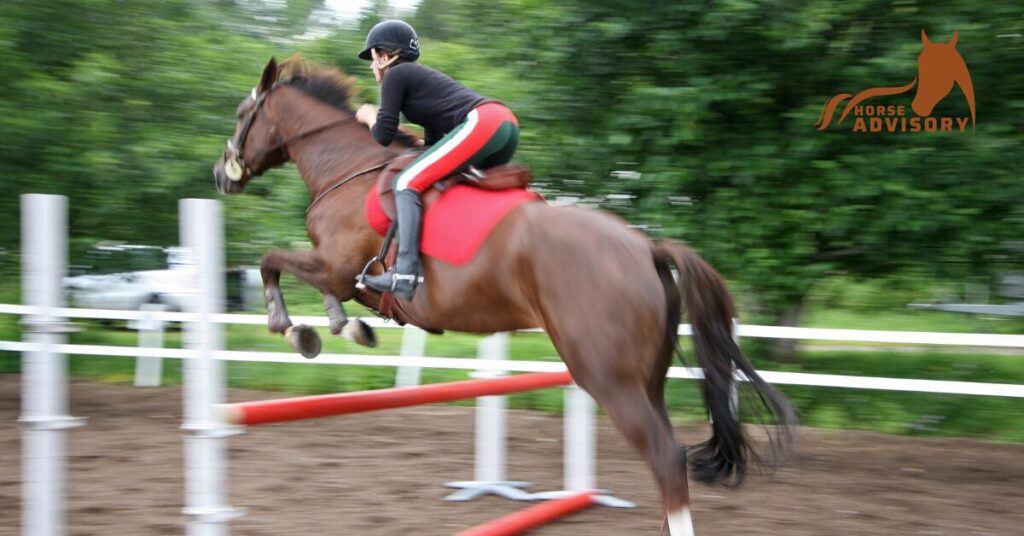Show jumping is a dynamic and demanding equestrian sport that tests the agility, speed, and coordination of both horse and rider. Arabian horses, known for their agility and willingness to learn, can excel in this sport when properly trained. This blog post will guide you through the essential steps to train your Arabian horse for show jumping, from understanding the basics to maintaining health and fitness.
Understanding the Basics of Show Jumping
Before diving into training, it’s crucial to understand the fundamentals of show jumping. This sport involves navigating a course of obstacles, including verticals, oxers, and combinations, within a set time. The goal is to complete the course with the fewest faults, which can be incurred by knocking down poles, refusing jumps, or exceeding the time limit. Successful show jumping requires precise communication between horse and rider, as well as the horse’s ability to adjust stride length and maintain balance.

Creating a Training Regimen for Show Jumping
A well-structured training regimen is vital for enhancing your horse’s show jumping skills. By focusing on key elements like warm-up routines and flatwork, you can help develop your horse’s strength, agility, and obedience, which are critical for success in the arena.
Warm-Up Routine
The warm-up routine is crucial for preparing your horse’s muscles and joints for the physical demands of training. A proper warm-up helps prevent injuries by gradually increasing the heart rate and loosening muscles, ensuring your horse is physically ready for more intense exercise. Additionally, it helps to focus your horse’s mind, transitioning them from resting to working mode.
Begin with 10-15 minutes of walking to gently increase blood flow to the muscles. Progress to a trot, maintaining a steady pace to further elevate the heart rate and enhance muscle elasticity. During this phase, incorporate lateral movements such as leg-yields, which aid in improving flexibility and coordination. Practice transitions between walking and trotting to boost responsiveness and prepare the horse mentally and physically for more complex exercises. This gradual approach ensures that your horse is ready for the demands of jumping without risking strain or injury.
Flatwork
Flatwork forms the foundation of a horse’s training, significantly impacting their balance, rhythm, and obedience. These skills are crucial for successful jumping, as they enable the horse to approach and navigate jumps with precision and confidence. Consistent flatwork training enhances the horse’s ability to respond to the rider’s aids promptly, creating a harmonious partnership that is essential for tackling challenging courses.
Focus on exercises that build strength and control, such as circles and serpentines. These exercises improve the horse’s balance and rhythm by encouraging them to maintain a consistent pace and bend correctly. Leg-yields are particularly beneficial for developing lateral flexibility and obedience, helping the horse to move off the leg and refine their body alignment. Additionally, practice transitions between gaits—such as walk to trot, trot to canter, and back—to enhance the horse’s responsiveness and agility. These transitions teach the horse to listen and react to subtle cues, which is vital for adjusting strides between jumps.
Building Strength and Agility
To excel in show jumping, a horse requires both strength and agility. By integrating specific exercises like hill work and gymnastic grids into your training regimen, you can significantly enhance these attributes, paving the way for success in the ring.
Hill Work
Hill work is a powerful exercise for building muscle and improving cardiovascular fitness in horses. Trotting and cantering on varying inclines naturally engage the horse’s hindquarters, core, and forelimbs, promoting balanced muscle development. Additionally, the increased effort required to navigate hills boosts cardiovascular endurance, an essential component for sustaining energy during competitive events.
Incorporate hill work into your training sessions 1-2 times a week to prevent overexertion. Begin with gentle slopes and shorter durations, progressively challenging your horse with steeper inclines and longer sessions as they gain strength and confidence. Varying the terrain keeps the workouts engaging and ensures comprehensive muscle conditioning. Always ensure your horse is adequately warmed up before undertaking hill exercises to reduce the risk of injury.
Gymnastic Grids
Gymnastic grids are instrumental in refining a horse’s jumping technique, enhancing their balance, and boosting their confidence. By requiring precise footwork and timing, these exercises encourage the horse to think quickly and adjust their body position efficiently. This leads to more controlled and confident jumps during competitions.
Start with simple grids, such as a series of trot poles leading to a small jump, to familiarize your horse with the concept and build their confidence. As your horse becomes more comfortable, gradually introduce more complex combinations, incorporating varied jump heights and distances. Pay close attention to the spacing between elements, adjusting them to suit your horse’s stride length and ability. This ensures your horse can navigate the grid smoothly and without unnecessary strain. Regularly practicing gymnastic grids will foster a more agile and responsive jumper, ready to tackle even the most challenging courses with poise.
Practicing Jumping Techniques for Your Arabian Horse
Mastering various jumping techniques is crucial for your Arabian horse to excel in show jumping. By focusing on approach and takeoff, as well as landing and recovery, you can enhance your horse’s performance and confidence in the ring.
Approach and Takeoff
A correct approach and takeoff are foundational for a successful jump, influencing both the trajectory and safety of the horse. A steady rhythm and straightness during the approach help the horse to evaluate the jump and prepare their body for the takeoff, ensuring optimal lift and clearance.
Begin by practicing a controlled canter towards single fences, emphasizing the maintenance of a consistent rhythm and straightness. Use ground poles placed before the jump to aid your horse in judging the takeoff point accurately. These markers help the horse to measure their strides and prepare mentally and physically for the jump. As your horse becomes more skilled, vary the height and type of fences to challenge their adaptability and reinforce the importance of a precise approach.
Landing and Recovery
Efficient landing and recovery are vital for maintaining balance and preparing for subsequent jumps. A smooth landing reduces strain on the horse’s legs and joints, while a balanced canter departure sets up a stable approach for the next obstacle.
After each jump, focus on achieving smooth landings followed by balanced canter departures. Encourage your horse to land softly and immediately regain their composure. Incorporate lines of fences in your training sessions to practice maintaining rhythm and balance between jumps, which is essential for tackling combinations and complex courses. This routine not only enhances your horse’s physical capabilities but also improves their mental acuity, enabling them to handle varying jump sequences with ease.
Maintaining Health and Fitness for Peak Performance
Ensuring your horse’s health and fitness is crucial for their performance in show jumping. By focusing on a balanced diet, regular veterinary care, and adequate rest and recovery, you can support your horse’s well-being and optimize their athletic potential.
Balanced Diet
Proper nutrition is foundational for muscle development, sustained energy levels, and overall health. A well-balanced diet ensures that your horse receives all necessary nutrients to maintain peak physical condition and perform at their best.
Provide your horse with a diet rich in high-quality forage, such as hay or pasture, to meet their fiber needs and support digestive health. Complement this with grains that offer additional energy and protein, and incorporate appropriate supplements to address any specific nutritional requirements. Consulting with a veterinarian or equine nutritionist is essential to tailor the diet based on your horse’s age, workload, and health status, ensuring they receive the optimal balance of nutrients.
Regular Veterinary Care
Regular veterinary care is critical for maintaining your horse’s health and soundness. Routine check-ups can detect potential issues early, preventing them from impacting your horse’s performance and well-being.
Schedule regular veterinary visits to keep up with vaccinations, dental care, and overall health assessments. These check-ups help ensure your horse is free from pain and discomfort, allowing them to perform optimally. Additionally, be vigilant in monitoring your horse for any signs of discomfort or lameness, and address any issues promptly with professional guidance to maintain their health and readiness for training and competition.
Rest and Recovery
Adequate rest and recovery are vital for preventing injuries and avoiding mental fatigue. Allowing your horse time to recuperate ensures they are physically and mentally prepared for the demands of training and competition.
Incorporate rest days into your training schedule to give your horse’s muscles time to repair and strengthen. Provide ample turnout time to promote natural movement and relaxation. Post-training, use cooling down routines and proper grooming practices to aid in recovery and prevent muscle soreness. These routines not only support physical recovery but also contribute to your horse’s overall happiness and well-being.
Conclusion
Training your Arabian horse for show jumping requires a combination of structured exercise, skill development, and diligent health maintenance. By understanding the basics of show jumping, creating a comprehensive training regimen, building strength and agility, practicing jumping techniques, and maintaining your horse’s health and fitness, you can set your Arabian horse up for success in this exciting and challenging sport. With dedication and consistent effort, you and your horse will be well-prepared to navigate the show jumping arena with confidence and skill.





